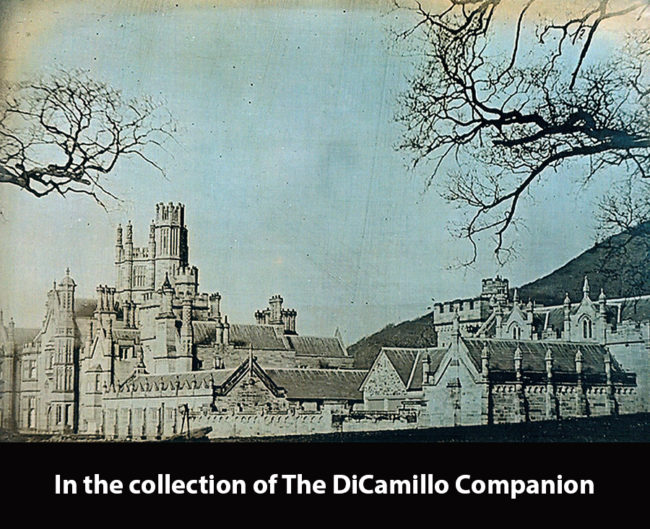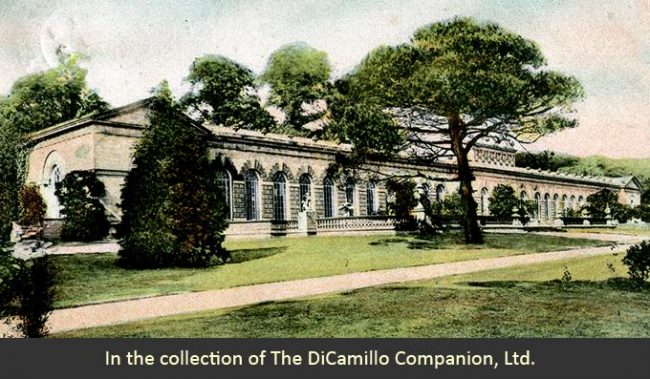
The house from a circa 1905 postcard

A copy of the earliest known Welsh photograph, a daguerreotype of the castle, taken on March 9, 1841 by The Rev. Calvert Richard Jones. The original is in the collection of the National Library of Wales.

The famous 300-foot-long orangery from a 1907 postcard
Earlier Houses: There have been a number of earlier buildings on the site of the current house, including the 11th century Cistercian Margam Abbey, which was converted into Margam House in the 1530s. The man who carried this out was Sir Rice (Rhys) Mansel, chamberlain of Chester to Henry VIII and high sheriff of Glamorgan, who purchased the abbey buildings from the crown during the Dissolution of the Monasteries; Margram remained the property of his descendants until 1941. Margam House became the largest and most important country house in Glamorgan; it was demolished in the 1790s and replaced by the current Margam Castle in the early 19th century.
Built / Designed For: Christopher Rice Mansel Talbot
House & Family History: William Henry Fox Talbot, the inventor of modern photography and a relation of Christopher Rice Mansel Talbot, the builder of Margam Castle, was a frequent visitor and used the castle in some of his early photographic experiments. Margam was also the subject of the earliest known Welsh photograph, a daguerreotype of the castle taken on March 9, 1841, by The Rev. Calvert Richard Jones (see "Images" section). Margam Castle is supposedly haunted by a bevy of active spectres and has become a popular center for paranormal investigation.
Collections: Much of the collection at Margam was formed in the 18th century by Thomas Mansel Talbot and originally housed at Penrice Castle. In 1941 there was an auction of the contents of Margam by Christie's. A Roman marble bust of a child (circa 200 AD, probably from Aphrodisias), once in the collection of Margam, has been, since 1994, in the collection of the Museum of Fine Arts, Boston.
Garden & Outbuildings: Legend has it that, when a ship carrying a gift of orange trees from Philip II of Spain to Elizabeth I was wrecked off the coast of Glamorgan, the trees were saved and housed in an outbuilding at Margam. Today one of the finest classical buildings in Wales is the successor to that earlier home of the orange trees: the 18th century, Grade I-listed Margam Orangery. Built of Pyle stone, the building was designed by Anthony Keck and is the longest orangery in the British Isles: 300 feet, with a 27-window front. The rear section was built using material from the old, derelict house, which was demolished in the 1790s. The two end pavilions were originally used for the housing and display of antiquities purchased in Italy in the 18th century by Thomas Mansel Talbot when he was on his Grand Tour. By the mid-19th century there were 110 orange trees in the orangery.
Architect: Edward Haycock Sr.
Date: 1830-40Architect: Thomas Hopper
Date: 1830-40Architect: Anthony Keck
Date: 1786-93
Title: Follies and Pleasure Pavilions
Author: Mott, George; Aall, Sally Sample
Year Published: 1989
Publisher: New York: Harry N. Abrams, Inc.
ISBN: 0810911752
Book Type: Hardback
House Listed: Grade I
Park Listed: Grade I
Past Seat / Home of: SEATED AT EARLIER HOUSE: Sir Rice (Rhys) Mansel, 1537-59; Sir Edward Mansel, 1559-95; Thomas Mansel Talbot, 18th century. SEATED AT CURRENT HOUSE: Christopher Rice Mansel Talbot, 1840-90; Emily Charlotte Talbot, 1890-1918; Andrew Mansel Talbot Fletcher, 1918-41. Sir David Martyn Evans-Bevan, 1st Bt., 1942-73.
Current Ownership Type: Government
Primary Current Ownership Use: Visitor Attraction
Ownership Details: Owned by Neath Port Talbot County Borough Council
House Open to Public: Yes
Phone: 01639-881-635
Email: [email protected]
Website: http://www.margamcountrypark.co.uk/
Historic Houses Member: No